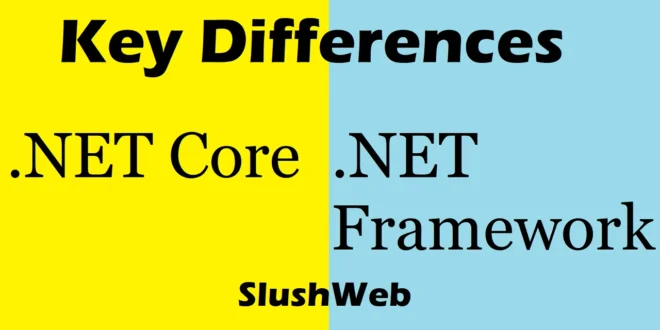In the ever-evolving world of software development, the choice of a framework is a pivotal decision that profoundly impacts the development process, deployment strategies, and long-term maintenance of applications. One of the central debates in the .NET ecosystem revolves around .NET Core and .NET Framework, two distinct frameworks with unique characteristics. This blog post aims to explore the key differences between .NET Core and .NET Framework, shedding light on their features, use cases, and implications for developers and businesses.
Before delving into the differences, let’s briefly revisit the origins of the .NET Core and .NET Framework.
.NET Framework
The .NET Framework, initially released in 2002, has been the bedrock of Microsoft’s development ecosystem for nearly two decades. Designed for Windows-centric development, it excelled in building desktop applications, web applications, and enterprise solutions. Over the years, the .NET Framework has undergone multiple updates, enriched its library ecosystem, and introduced new features.
.NET Core
In contrast, .NET Core emerged as a requirement to the growing needs of the software development landscape. First introduced in 2016, .NET Core was a departure from the monolithic nature of its predecessor. It aimed to address the demands of cross-platform development, containerization, microservices architecture, and modern cloud-based applications.
.NET Framework: A Closer Look
Windows-Centric Development
The .NET Framework has been inherently tied to the Windows operating system. It seamlessly integrates with Windows environments, offering optimal performance and compatibility. Hire .NET Developers leveraging .NET Framework have excelled in creating Windows desktop and traditional web applications tailored to the Windows platform.
Monolithic Deployment Model
One of the distinctive aspects of the .NET Framework is its monolithic deployment model. When deploying applications, developers often bundle a sizable runtime with the application, leading to larger application sizes. While this model ensures that applications are self-contained, it can pose challenges in terms of updates, particularly when considering the entire runtime needs to be updated.
Full Framework Libraries
The .NET Framework boasts an extensive set of .NET core libraries, providing developers with a comprehensive toolkit for building robust applications. However, these libraries are tightly coupled with the framework itself, limiting their cross-platform compatibility. This means that while the .NET Framework is rich in functionality, its scope is constrained to Windows environments.
Windows Forms and WPF
The .NET Framework has been the go-to choice for developers building Windows desktop applications, offering support for Windows Forms and Windows Presentation Foundation (WPF). These graphical user interface frameworks enable to creation of visually appealing and feature-rich desktop applications.
.NET Core: A Modern Approach to Development
Cross-Platform Compatibility
One of the paradigm shifts introduced by .NET Core is its commitment to cross-platform development. .NET Core applications can seamlessly run on Windows, Linux, and macOS, providing developers with unprecedented flexibility. This cross-platform support is particularly crucial in contemporary development scenarios where applications need to reach a diverse audience across different operating systems.
Modular Deployment
.NET Core adopts a more modular deployment approach. Unlike the monolithic nature of .NET Framework deployments, .NET Core allows developers to include only the necessary components in the deployment package. This results in more agile, efficient, and resource-friendly deployments. The modular approach aligns well with modern development practices, especially in the context of microservices and containerization.
NuGet Package System
Another significant departure from the .NET Framework is the use of the NuGet package system in .NET Core. This package management system streamlines the process of managing dependencies, providing a more modular and lightweight development experience. Developers can easily add or remove packages as needed, promoting flexibility and simplifying version management.
ASP.NET Core
For web development, .NET Core introduced ASP.NET Core, a modern and modular framework for building cross-platform, high-performance web applications. ASP.NET Core offers improved performance, scalability, and flexibility compared to its .NET Framework counterpart. It has become the framework of choice for building web applications that can thrive in diverse hosting environments, including cloud-based solutions.
Key Differences Explored
Platform Independence
Perhaps the most significant differentiator is the platform independence offered by .NET Core. While the .NET Framework remains deeply integrated with Windows, .NET Core’s cross-platform support expands the reach of applications. This distinction is vital in scenarios where multi-platform deployment is a requirement, such as cloud-based services or applications targeting a broad user base with diverse operating systems.
Deployment Model
The deployment models of .NET Core and .NET Framework highlight a fundamental shift in philosophy. .NET Core’s modular deployment model stands in stark contrast to the monolithic nature of .NET Framework deployments. The ability to include only the necessary components in .NET Core deployments leads to more efficient, smaller-sized applications. This not only aids in faster deployment but also simplifies updates and enhances resource utilization.
Library Compatibility
While .NET Core does not encompass the entirety of the libraries available in .NET Framework, it strikes a balance by providing a subset of essential libraries. This subset is designed to be more modular and compatible with modern development practices. The emphasis is on agility and compatibility with emerging technologies, enabling developers to build applications that align with contemporary development trends.
Future Development
The evolution of the .NET ecosystem has reached a critical juncture with the release of .NET 5 and subsequent versions. Microsoft has taken strides to converge .NET Core and .NET Framework into a unified platform. Developers are encouraged to adopt .NET 5 and later versions, representing a unified, cross-platform runtime. This convergence signifies a strategic move by Microsoft to provide developers with a unified development experience, leveraging the best features from both worlds.
Considerations for Decision-Making
Choosing Based on Project Requirements
Selecting between .NET Core and .NET Framework hinges on the specific requirements of a project. For applications targeting Windows environments with a legacy codebase, the .NET Framework might be a suitable choice. Conversely, for new developments requiring cross-platform compatibility, microservices architecture, or containerization, .NET Core or the unified .NET 5+ platform is the more strategic option.
Migration Strategies
Businesses with existing .NET Framework applications need to consider migration strategies. Microsoft’s commitment to unifying the ecosystem provides a path forward. However, the migration process should be approached cautiously, considering factors such as application complexity, dependencies, and the overall impact on the development lifecycle.
Developer Skillset
The skillset of your dedicated development team is a critical factor. If your team has a strong background in .NET Framework and the project requirements align with Windows-centric development, it might be pragmatic to continue leveraging .NET Framework. On the other hand, if cross-platform development and modern deployment strategies are in focus, investing in the skillset required for .NET Core or .NET 5+ becomes imperative.
Conclusion
The choice between .NET Core and .NET Framework is a nuanced decision that requires a thorough understanding of project requirements, development goals, and the evolving landscape of the .NET ecosystem. The historical context, key differences, and considerations provided in this exploration aim to empower developers, architects, and decision-makers to make informed choices aligned with their unique circumstances.
As we move forward, the unified .NET platform, represented by .NET 5 and beyond, emerges as a unifying force that bridges the strengths of .NET Core and .NET Framework. This convergence signals a strategic direction, promising a cohesive development experience that combines the best features of both frameworks. The journey ahead involves embracing this unified platform, staying abreast of updates, and leveraging the evolving capabilities of the .NET ecosystem to build innovative, scalable, and cross-platform applications.
Did you find this article helpful? You can check out our website for more awesome content like this.
 SlushWeb Live the Way You Love
SlushWeb Live the Way You Love



